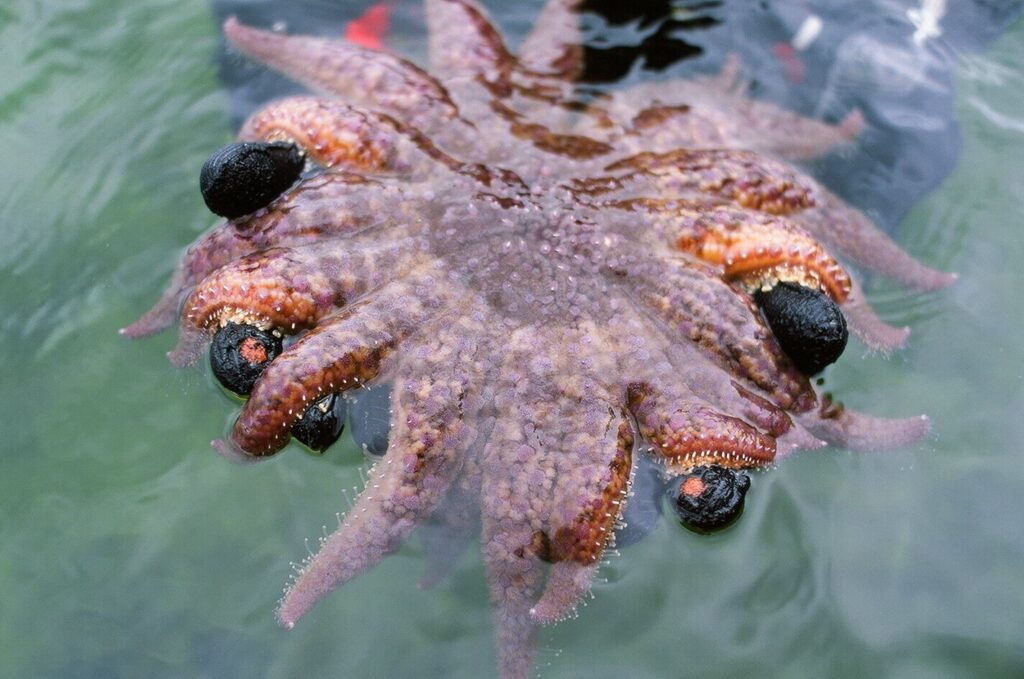
The sunflower sea star, known scientifically as Pycnopodia helianthoides, has emerged as a potential ally in the battle against the destruction of kelp forests by sea urchins. This revelation comes from a study conducted by ecologists and students at the University of California, Santa Cruz, who explored the interactions between these sea stars and kelp-hungry urchins in the coastal waters near Sitka, Alaska.
Published on July 9 in the journal Proceedings of the Royal Society B: Biological Sciences, the study highlights how the presence of sunflower sea stars can deter urchins from consuming kelp. This discovery is particularly significant as it offers a natural method to protect and restore these vital underwater ecosystems.
The Role of Sunflower Sea Stars
Sunflower sea stars are found throughout the intertidal and subtidal coastal waters of the northeast Pacific Ocean, ranging from Alaska to northern Baja California, Mexico. These sea stars, with their distinctive appearance, create a “landscape of fear” for red sea urchins, prompting them to steer clear of kelp forests.
According to Rae Mancuso, the study’s lead author, “It’s very gratifying to see our work published and presented as another way to protect and restore coastal kelp populations. Kelp forests are highly productive, economically important, and culturally valued ecosystems.”
Importance of Kelp Forests
Kelp forests serve as nurseries for thousands of marine species, including commercially significant ones like abalone and rockfish. Beyond their ecological value, these forests contribute an estimated $500 billion annually to the global economy, playing a crucial role in various industries from pharmaceuticals to food production.
However, a decade ago, kelp forests in California and Oregon suffered significant losses coinciding with the local extinction of sunflower sea stars due to a wasting disease outbreak in 2013. This has spurred interest in understanding the role of these sea stars in kelp forest dynamics and their potential in restoration efforts.
Research Methodology and Findings
The UC Santa Cruz study involved placing caged sunflower sea stars on the sea floor in areas where urchins had decimated kelp beds. Students, part of the university’s Marine Ecology Field Quarter course, conducted this research, gaining hands-on experience in aquatic studies.
Pairs of cages were set up at three different locations, with kelp blades attached as bait. One cage in each pair contained a sunflower sea star, while the other served as a control. After 24 hours, red urchins were observed maintaining an average distance of six feet from the kelp in cages with sea stars, demonstrating the deterrent effect.
“We show that the sea stars create a ‘landscape of fear’ among red sea urchins in degraded urchin barrens that reduces grazing on kelp,” said Kristy Kroeker, the study’s senior author and professor of ecology and evolutionary biology at UC Santa Cruz.
Implications for Kelp Forest Recovery
The study’s findings suggest that the conservation of sunflower sea stars could be a cost-effective strategy for controlling urchin populations, compared to labor-intensive methods like manual harvesting. The presence of these sea stars could help maintain the balance in marine ecosystems, facilitating the recovery of kelp forests.
Furthermore, the research opens avenues for exploring the impact of sunflower sea stars on other urchin species, such as the notorious purple sea urchins, which are known for their destructive grazing habits.
“My educated guess is that they will deter purple urchin grazing as well, but it’s a question of how much and for how long,” Kroeker noted. “There are many unknowns that need to be addressed and many steps that need to be taken between our results and the reintroduction of Pycnopodia for kelp-forest recovery.”
Looking Ahead
As the study suggests, the reintroduction of sunflower sea stars could play a pivotal role in the restoration of kelp forests. However, further research is necessary to understand the full scope of their impact on different urchin species and the long-term viability of this approach.
The collaboration between students and faculty at UC Santa Cruz exemplifies the potential of academic research to contribute to environmental conservation efforts. With continued exploration and support, the sunflower sea star could become a key player in preserving and revitalizing the precious kelp forests of the Pacific Ocean.





